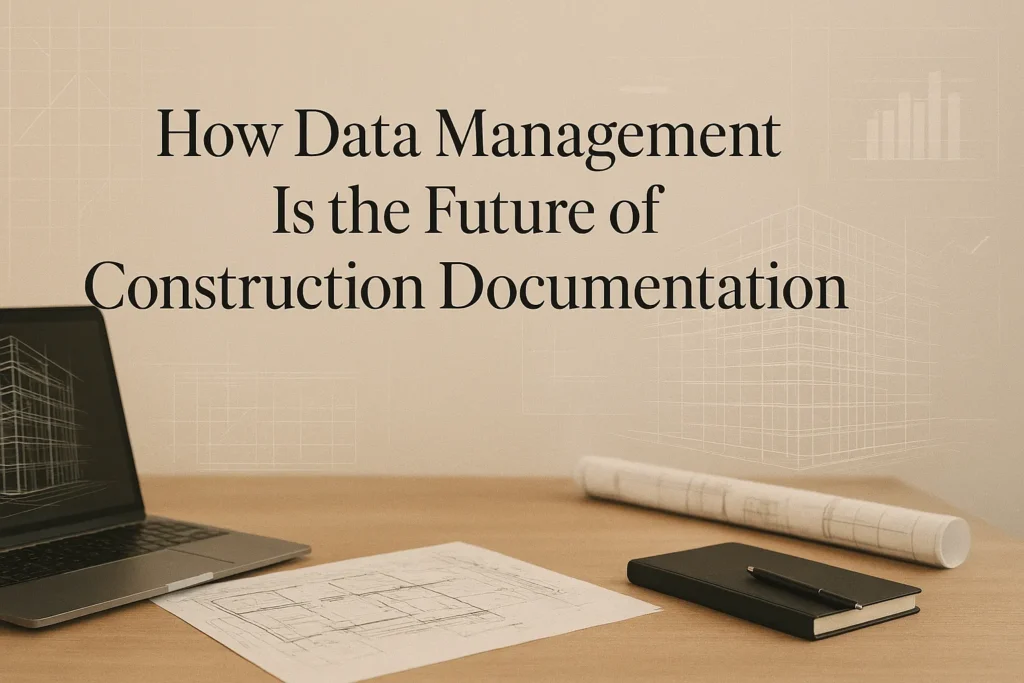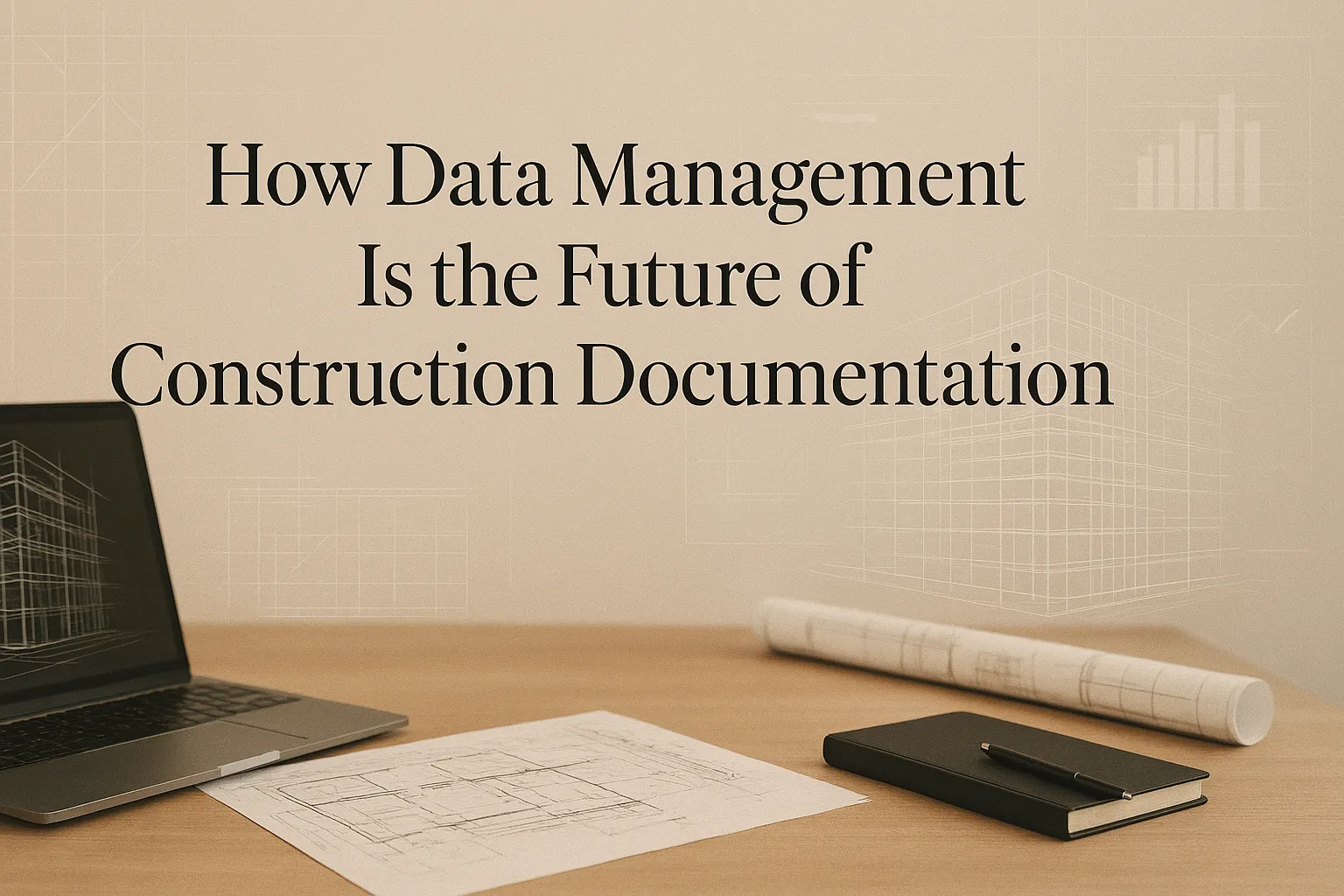In today’s fast-paced construction industry, construction data management has evolved from being a technical detail to a strategic necessity. With the growing complexity of projects, digital transformation, and increased collaboration between architects, engineers, BIM coordinators, and general contractors, managing information efficiently has become critical to achieving accuracy, compliance, and profitability.
Table of Contents
ToggleConstruction documentation used to revolve around static drawings and paper plans. Today, it encompasses an entire digital ecosystem — from 3D modeling and material estimates to permit tracking and real-time collaboration. That’s why organizations adopting robust data management practices are leading the next generation of construction efficiency and innovation.

What Is Construction Data Management?
Construction data management refers to the systematic collection, organization, storage, and use of all project-related data, such as architectural drawings, BIM models, RFIs, and site reports. It ensures that every stakeholder — from architectural design teams to engineers — can access the most accurate and updated information throughout the project lifecycle.
Unlike traditional documentation that risks data silos and version errors, digital data management enables a single source of truth. This not only boosts team collaboration but also strengthens project predictability and reduces costly rework caused by outdated information.
The Shift Toward Digital Documentation
The construction industry has witnessed a significant digital shift over the past decade. Tools like BIM services have redefined how information is visualized and shared. Instead of manually coordinating drawings, engineers and designers can now collaborate on centralized platforms that integrate architectural, structural, and MEP data seamlessly.
This transformation has also redefined how documentation is handled. Today, cloud‑based systems make it easier to store, retrieve, and update specifications. Smart document tagging, automated versioning, and real‑time project dashboards are all by‑products of better data management strategies.
Why Effective Data Management Matters
For mid- to large-scale construction projects, data fragmentation can quickly create chaos — conflicting designs, outdated approvals, or missed compliance updates. Effective construction data management ensures smoother communication flow, documentation accuracy, and greater transparency across teams.
- Accuracy: By unifying document storage, teams reduce the risk of using outdated drawings or conflicting design versions.
- Accountability: Every change is tracked, providing a clear digital footprint for auditing and permit compliance.
- Efficiency: With optimized data workflows, teams can deliver projects faster and with fewer miscommunications.
- Collaboration: Seamless data sharing strengthens coordination between engineers, architects, and contractors.
Integrating Data Management With BIM
The future of construction documentation is deeply tied to BIM (Building Information Modeling). A well‑structured BIM environment not only helps visualize complex architectural and structural components but also acts as a dynamic data hub. When combined with proper data management protocols, BIM becomes a live source of project intelligence.
For instance, every model element contains metadata — material type, quantity, performance values, and cost. These details, when properly managed, speed up project estimation and resource planning. BIM managers and engineers can extract actionable insights for forecasting, sustainability analysis, and facility management long after construction ends.
Need Help Managing Your Construction Data?
Design Sync Studio provides specialized documentation, BIM, and digital collaboration solutions for architects and project teams across the U.S. and Canada. Our experts can help you standardize workflows and streamline communication.
Call us now: +1‑215‑995‑4450 or visit our contact page to get started.
The Role of Data in Compliance and Permitting
Every construction project must comply with multiple local and international codes — structural, environmental, and safety standards. Managing this information manually often leads to missed requirements and delayed approvals. That’s where structured data collection and automation play a vital role.
When integrated with permit expediting services, digital documentation provides inspectors with cleaner, more accessible data. It also simplifies revisions and resubmissions, ensuring project momentum without administrative bottlenecks.
Connecting Design and Documentation
In a modern construction workflow, design intent and documentation accuracy must evolve together. For example, interior design professionals rely heavily on precise documentation for finishes, fittings, and equipment schedules. Integrating these details into centralized data platforms ensures that designers and contractors interpret specifications consistently.
Likewise, architectural design drawings can be seamlessly updated when field modifications occur. This bi‑directional information flow minimizes rework and maintains design integrity throughout construction.
Practical Steps to Improve Construction Data Management
Adopting data management processes may sound complex, but starting small can make a noticeable difference. Here’s how teams can begin:
- Centralize documentation: Store all materials, drawings, and reports in one shared system, accessible to all stakeholders.
- Define data standards: Create protocols for file naming, versioning, and data access rights to prevent confusion.
- Integrate BIM workflows: Leverage BIM services for geometry and data synchronization across disciplines.
- Automate reporting: Use software tools that auto‑generate inspection reports and track design changes in real time.
- Train your team: Ensure engineers, coordinators, and designers understand standards for capturing and uploading project information.
With these steps, organizations can turn their scattered records into powerful, data‑driven assets that support continual improvement and accountability.
The Future of Documentation Is Intelligent
In the near future, AI‑assisted data management, predictive modeling, and digital twins will further revolutionize construction documentation. Smart platforms will not only record information but anticipate design conflicts, cost overruns, and material shortages before they impact the project. As construction becomes increasingly data‑centric, those who invest early in digital documentation systems will see exponential returns.
Ultimately, construction data management is more than a technology trend — it represents an essential cultural shift in how we view information, collaboration, and accountability across every stage of the building lifecycle.
Frequently Asked Questions (FAQs)
1. What is the main purpose of construction data management?
Its primary goal is to organize all project documentation into one reliable digital system, reducing errors, improving collaboration, and ensuring real‑time access for all team members.
2. How does BIM improve data management?
BIM platforms unify geometric and data information into one digital model, enabling faster decision‑making and improving design consistency across disciplines.
3. Can small construction firms benefit from data management?
Absolutely. Even small teams gain efficiency from centralized documentation, especially for compliance tracking and document sharing with external partners.
4. How does data management support permit approvals?
Digital documentation ensures that drawings, specifications, and revisions remain compliant and accessible to authorities, making permit expediting smoother and faster.
5. What’s the next evolution for construction documentation?
The future lies in AI‑enhanced, cloud‑native systems capable of connecting project, cost, and performance data — ultimately turning construction documentation into a living digital record throughout a building’s life.


